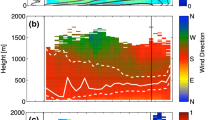Abstract
A time-dependent integrated dynamical boundary-layer model is used to study various features of the nocturnal low-level jet (LLJ). The basic concept is that of Thorpe and Guymer (1977). It is extended by entrainment processes, advection and an equation for the upper height of the turbulent layer. Applications show the role of the energy terms and how the LLJ changes considerably under synoptic forcing processes of variable geostrophic wind.
Similar content being viewed by others
References
Blackadar, A. K.: 1957, ‘Boundary Layer Wind Maxima and their Significance for the Growth of Nocturnal Inversions’,Bull. Amer. Meteorol. Soc. 38, 283–290.
Brost, R. A. and Wyngaard, J. C.: 1978, ‘A Model Study of the Stably Stratified Planetary Boundary Layer’,J. Atm. Sci. 35, 1427–1440.
Clarke, R. H.: 1970, ‘Observational Studies in the Atmospheric Boundary Layer’,Quart. J. Roy. Meteorol. Soc. 96, 91–114.
Clarke, R. H., Dyer, A. J., Brook, R. R., Reid, D. G., Troup, A. J.: 1971, ‘The Wangara Experiment: Boundary Layer Data’. CSIRO Div. Meteor. Phys. Techn. Paper No.19.
Clarke, R. H. and Brook, R. H.: 1979, ‘The Koorin Expedition — Atmospheric Boundary Layer Data over Tropical Savannah Land’, Bureau of Meteorology, Australia.
Deardorff, J. W.: 1972, ‘Parameterization of the Planetary Boundary Layer for Use in General Circulation Models’,Mon. Weather Rev. 100, 93–106.
Garratt, J. R.: 1982a, ‘Observations in the Nocturnal Boundary Layer’,Boundary-Layer Meteorol. 22, 21–48.
Garratt, J. R.: 1982b, ‘Surface Fluxes and the Nocturnal Boundary-Layer Height’,J. Appl. Meteorol. 21, 725–729.
Kraus, H. and Schaller, E.: 1978, ‘Steady-State Characteristics of Inversions Capping a Well-Mixed Planetary Boundary Layer’,Boundary-Layer Meteorol. 14, 83–104.
Lettau, H.: 1964, ‘Preliminary Note on the Effect of Terrain-Slope on Low-Level Jets and Thermal Winds in the Planetary Boundary Layer’, Section 4 ofStudies of the Effects of Variations in Boundary Conditions on the Atmospheric Boundary Layer, Ann. Rept. DA-36-039-AMC-00878 Univ. of Wisc., Dept. of Meteor., Madison, Wisc.
Lilly, D. K.: 1968, ‘Models of Cloud-Topped Mixed Layers Under a Strong Inversion’,Quart. J. Roy. Meteorol. Soc. 94, 292–309.
Mahrt, L.: 1981, ‘The Early Evening Boundary Layer Transition’,Quart. J. Roy. Meteorol. Soc. 107, 329–343.
Peagle, J. and Rasch, G. E.: 1973, ‘Three-Dimensional Characteristics of Diurnally Varying Boundary-Layer Flows’,Mon. Weather Rev. 101, 746–750.
Roth, R., Kottmeier, Chr., Lege, D., and David, F.: 1981, ‘Ekman-Schicht-Windmaxima’, Institut für Meteorologie und Klimatologie der Universität Hannover.
Sheih, C. M.: 1972, ‘Theoretical Study of the Diurnal Wind Variations in the Planetary Boundary Layer’,J. Atm. Sci. 29, 995–998.
Thorpe, A. J. and Guymer, T. H.: 1977, ‘The Nocturnal Jet’,Quart. J. Roy. Meteorol. Soc. 103, 633–653.
Wippermann, F.: 1973, ‘Numerical Study on the Effects Controlling the Low-Level Jet’,Beitr. Phys. Atmosph. 46, 137–154.
Wyngaard, J. C. and Coté, O. R.: 1971, ‘The Budgets of Turbulent Kinetic Energy and Temperature Variance in the Atmospheric Surface Layer’,J. Atm. Sci. 28, 190–201.
Zilitinkevich, S. S.: 1972, ‘On the Determination of the Height of the Ekman Boundary Layer’,Boundary-Layer Meteorol. 3, 141–145.
Author information
Authors and Affiliations
Rights and permissions
About this article
Cite this article
Malcher, J., Kraus, H. Low-level jet phenomena described by an integrated dynamical PBL model. Boundary-Layer Meteorol 27, 327–343 (1983). https://doi.org/10.1007/BF02033743
Received:
Issue Date:
DOI: https://doi.org/10.1007/BF02033743




